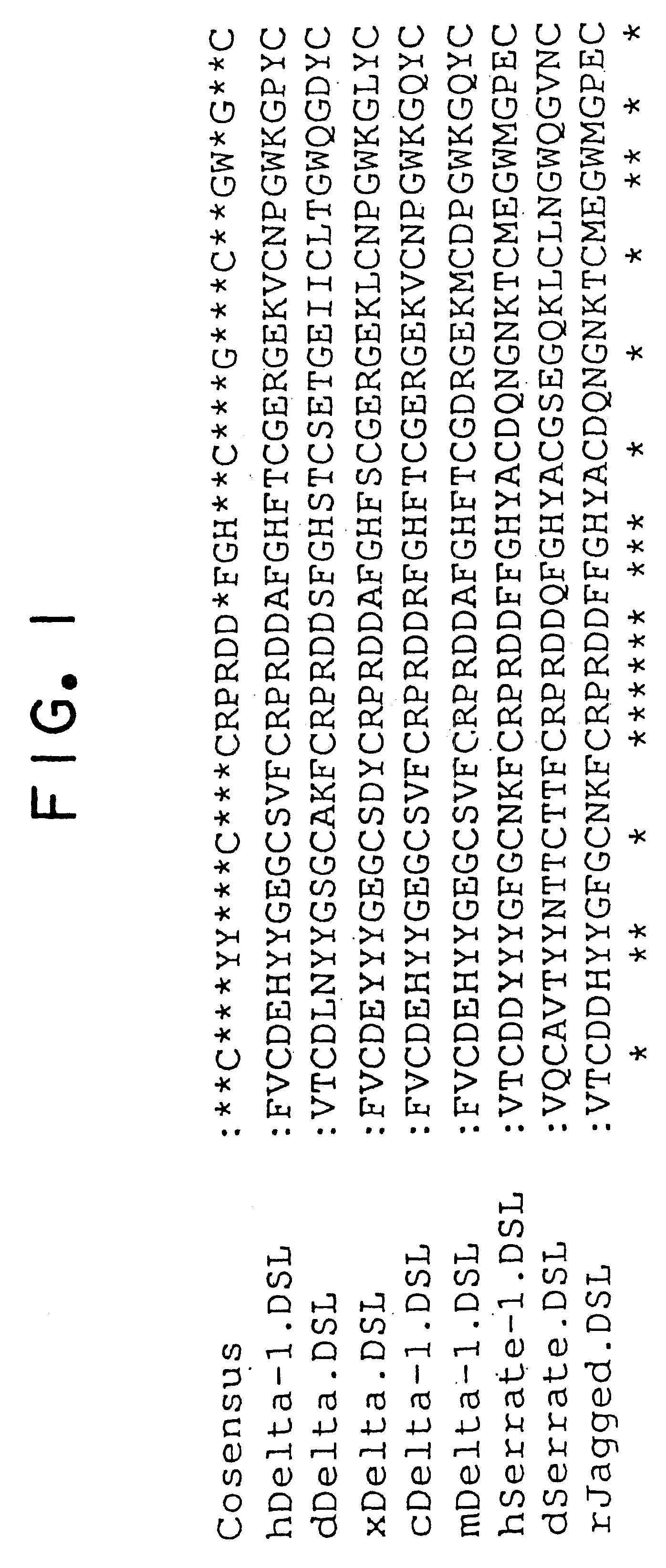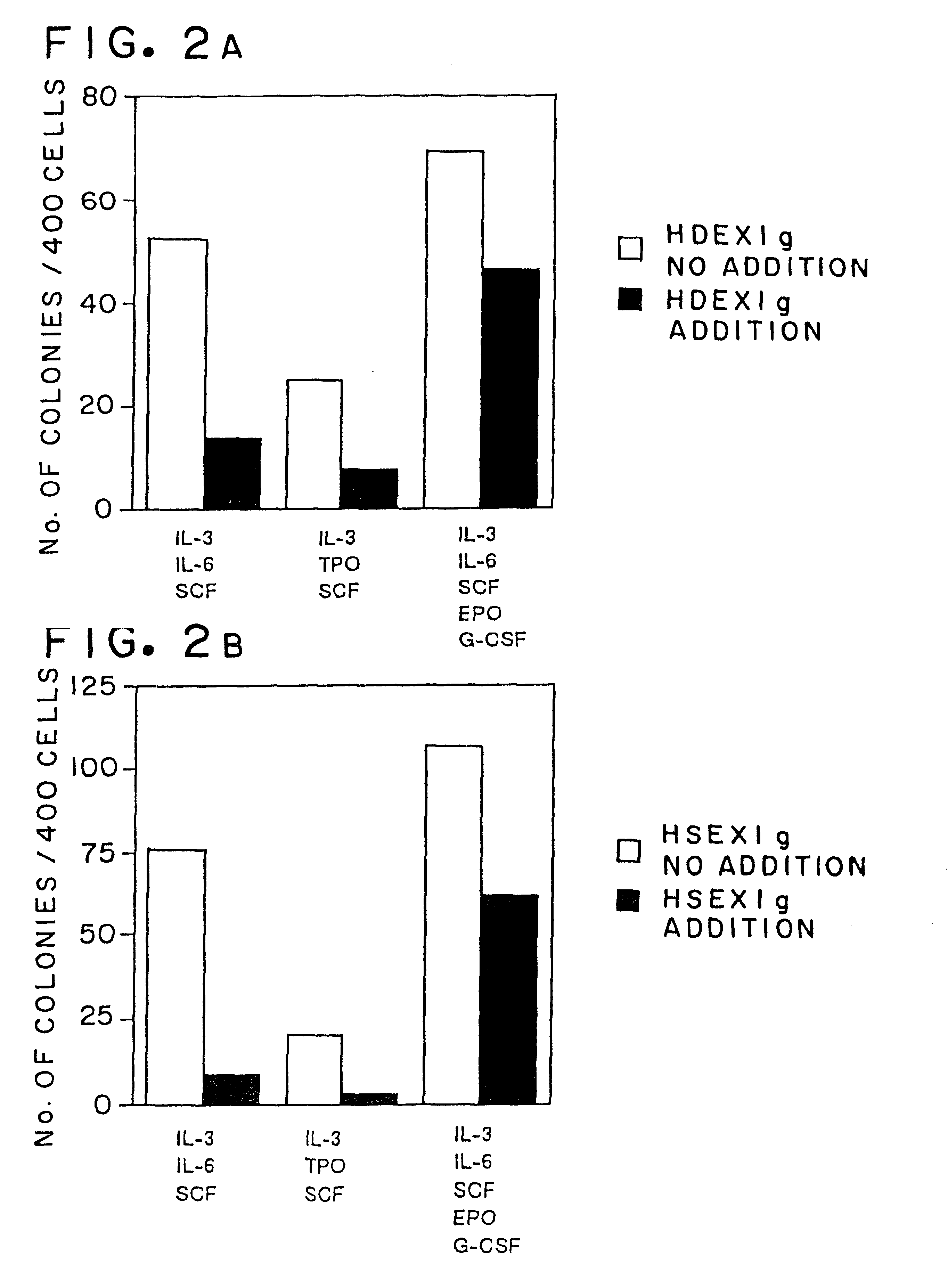Differentiation-suppressive polypeptide
a polypeptide and differentiation-suppression technology, applied in the field of differentiation-suppressive polypeptides, can solve the problems of insufficient knowledge of factors suppressing differentiation of undifferentiated cells, inability to maintain specificity, etc., and achieve the effect of strong physiological activity
- Summary
- Abstract
- Description
- Claims
- Application Information
AI Technical Summary
Benefits of technology
Problems solved by technology
Method used
Image
Examples
example 1
Cloning of PCR Products Using Human Delta-1 Primer and Determination of Base Sequence
A mixed primer corresponding to amino acid sequence conserved in C-Delta-1 and X-Delta-1, i.e. sense primer DLTS1 (sequence listing, SEQ ID NO: 14) and antisense primer DLTA2 (sequence listing, SEQ ID NO: 15), were used.
A synthetic oligonucleotide was prepared by using automatic DNA synthesizer with the principle of immobilized method. The automatic DNA synthesizer used was 391PCR-NIATE of Applied Biosystems Inc., U.S.A. Nucleotide, carrier immobilized with 3'-nucleotide, solution and reagents are used according to the instructions by the same corporation. Oligonucleotide was isolated from the carrier after finishing the designated coupling reaction and treating the oligonucleotide carrier, from which protective group of 5'-teminal was removed, with concentrated liquid ammonia at room temperature for one hour. For removing the protective groups of nucleic acid and phosphoric acid, the reactant solut...
example 2
Cloning of Full Length Novel Human Delta-1 and its Analysis
A screening of clones having full length cDNA was performed by hybridization from human placenta origin cDNA library (inserted cDNA in .lambda.gt-11, CLONTECH Inc., U.S.A.) in plaques corresponding to 1.times.10.sup.6 plaques. Generated plaques were transfered onto nylon filter (Hybond N+: Amersham Inc., U.S.A.). The transcribed nylon filter was subjected to alkaline treatment [allow to stand for 7 minutes on the filter paper permeated with a mixture of 1.5 M NaCl and 0.5 M NaOH], followed by two neutralizing treatments [allow to stand for 3 minutes on the filter paper permeated with a mixture of 1.5 M NaCl, 0.5 M Tris-HCl (pH 7.2) and 1 mM EDTA]. Subsequently, the filter was shaken for 5 minutes in the 2-fold concentrated SSPE solution [0.36 M NaCl, 0.02 M sodium phosphate (pH 7.7) and 2 mM EDTA], washed and air-dried. Then the filter was allowed to stand for 20 minutes on the filter paper, which was permeated with 0.4 M Na...
example 3
Cloning of Human Serrate-1 Specific PCR Product and Determination of Base Sequence
A mixed primer, which corresponded to amino acid sequence conserved in Drosophila Serrate and rat Jagged, i.e. sense primer SRTS1 (the sequence listing, SEQ ID NO: 16) and antisense primer SRTA2 (the sequence listing, SEQ ID NO: 17), was used. Preparation was conducted by the same way as described in Example 1.
Amplification by PCR using these primers was performed as follows. To the human fetal brain originated cDNA mixed solution hereinbefore 1 .mu.l was added 10.times.buffer solution (described in Example 1) 5 .mu.l, said dNTP mixture 4 .mu.l, sense primer SRTS1 (100 pmol / .mu.l) 5 .mu.l and antisense primer SRTA2 (100 pmol / .mu.l) 5 .mu.l specific to Serrate-1 homologue hereinbefore, and said TaqDNA polymerase 0.2 .mu.l, and finally added deionized water to set up total volume 50 .mu.l. The mixture was treated for 5 cycles of a cycle consisting of at 95.degree. C. for 45 seconds, at 42.degree. C. for ...
PUM
 Login to View More
Login to View More Abstract
Description
Claims
Application Information
 Login to View More
Login to View More - R&D
- Intellectual Property
- Life Sciences
- Materials
- Tech Scout
- Unparalleled Data Quality
- Higher Quality Content
- 60% Fewer Hallucinations
Browse by: Latest US Patents, China's latest patents, Technical Efficacy Thesaurus, Application Domain, Technology Topic, Popular Technical Reports.
© 2025 PatSnap. All rights reserved.Legal|Privacy policy|Modern Slavery Act Transparency Statement|Sitemap|About US| Contact US: help@patsnap.com



